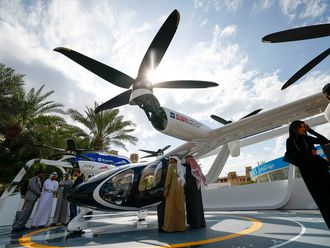
London / Toulouse: Airbus Group SE announced a drastic cut in production of its flagship A380 superjumbo, acknowledging that demand has fallen far short of original projections and raising the prospect of the world’s biggest passenger plane being prematurely axed.
The build rate for the double-decker will be slashed by more than half to one plane a month by 2018, Airbus revealed on Tuesday. Contrasting with the success of the rest of the Airbus line, the company delivered the surprise damper just hours after pulling in several massive orders for its popular A320-type single-aisle jet at the Farnborough Air Show in the UK.
Facing an almost inevitable demise just a decade into commercial operation, the A380 never met Airbus’s aspirations, and the company has long since given up on recouping its €25 billion ($28 billion, Dh101 billion) in development costs. Demand evaporated in recent years with the introduction of more nimble twin-engined jets, leaving Emirates of Dubai as the only carrier to fully embrace the giant aircraft.
Having once predicted that airlines would buy 1,200 supersize-planes over two decades, Airbus has had to settle for a far more modest reality. It has delivered only 193 A380s with 126 orders left to fill, though some of them are unlikely ever to materialise, and says the planned rate cut will put future output “in line with the current order intake”.
Perilous position
Even with Airbus seeking to reduce programme costs to allow the A380 to remain viable at lower production levels, the severity of the planned rate cut suggests the programme is on the brink of a terminal decline. While a break-even rate of 27 deliveries achieved in 2015 should be cut to 20 next year, that’s still eight more than Airbus is counting on from 2018, putting the plane in a perilous position regardless of jetliner unit chief Fabrice Bregier’s declaration that “the A380 is here to stay”.
“It won’t recover from this,” said Richard Aboulafia, an aviation consultant at Teal Group in Fairfax, Virginia. “The new rate is seriously uneconomic; therefore, it will die in a few years.”
Airbus shares fell as much as 3 per cent and were trading 0.8 per cent lower at €51.80 as of 10.57am in Paris. The stock has declined 17 per cent this year, valuing the company at €40 billion.
Popular with travellers because of its wide open spaces, even when filled with the regulation 550 seats, the A380 has been less of a hit with the world’s airlines. While Emirates has ordered more than 140 of the planes and has around 80 in service, only two other operators, Singapore Airlines Ltd. and Australia’s Qantas Airways Ltd., have bought 20 aircraft or more.
Emirates said in an emailed statement that it’s 2018 A380 deliveries “will not be impacted” by Airbus’s production slowdown, while offering no comment on the repercussions of the decision. The biggest long-haul airline, which has built its business model largely around the A380, had been pressing for a revamped version in order to safeguard superjumbo operations for a decade or more.
Flagship role
Even large global carriers such as British Airways and Air France operate the A380 in small batches, deploying it as a flagship aircraft to be used on a handful of high-profile routes and for photo opportunities, rather than the mass-transit workhorse that Airbus had intended it to be. To most airlines, the double-decker remains an exotic addition at best, rather than the backbone of a long-distance fleet.
Not a single US carrier has bought the A380, and Japanese airlines, leading clients for older leviathans like the Boeing Co. 747, have taken just a handful. The model is by far Airbus’s most expensive, commanding a list price of $432.6 million (Dh1.5 billion), although customers typically get steep discounts. There are so far no second-hand A380s in the market, making the plane’s resale value hard for operators and leasing companies to predict.
New contracts have been few and far between in recent years, with the A380 escaping an order blank for 2015 only when a deal for three planes announced by Japan’s All Nippon Airways Co. earlier this year was backdated. Iran’s outline purchase of 12 A380s, revealed in January, lifted the gloom briefly, before the government in Tehran said it may not translate into orders for five years, and only then if the country decides it really needs the planes.
With no hint of further contracts and the A380 wowing crowds rather than fleet managers at this week’s Farnborough show south of London, 2016 “looks particularly grim,” said Hans Weber, president of San Diego-based consultancy Tecop International Inc., adding that he, too, views the rate cut as “the beginning of the end.”
Rival theories
At the heart of the A380’s failure is a bet taken by Airbus on the direction of global aviation, with the company arguing when pitching the model that global “megacities”, increasingly crowded hubs and Asian economic expansion would spur demand for legions of superjumbos across the planet. It’s a theme the company reiterated in Tuesday’s release, saying the double-decker provided the “one and only solution for sustainable growth at congested airports.”
Boeing saw things differently, suggesting globalisation would demand higher frequencies on trunk routes combined with a multiplicity of new services linking smaller cities — all best served by mid-sized wide-bodies. Its response was to build the 787 Dreamliner and update the bestselling 777 range. It’s own 747-8, the latest iteration of its once popular jumbo jet, has encountered a reception from buyers even more lukewarm than the A380’s.
Airbus itself seems slowly to have been coming around to Boeing’s view. Until recently, it was pressing airlines to endorse an engine-upgrade plan aimed at breathing new life into the programme.










